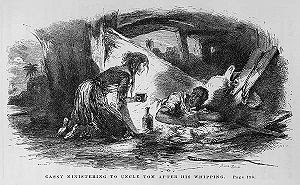This Day in History: March 20, 1852
 |
| Uncle Tom's Cabin, Boston edition Image Source: en.wikipedia.org |
For Northerners, the story made them acutely aware of the horrors of slavery far more personally than ever before. Southerners met the book with outrage even to the point of claiming distortions and overstatements. Regardless of the number of likes vs. dislikes, debates and discussions, Uncle Tom's Cabin was a runaway best seller.
At the start of the American Civil War, it has been recorded that Abraham Lincoln upon meeting Harriet Beecher Stowe commented, "So you're the little woman who wrote the book that made this great war."
In response to the criticisms, in 1853 Stowe published A Key to Uncle Tom's Cabin, an attempt to document the veracity of the novel's depiction of slavery. In the book, Stowe discusses each of the major characters in Uncle Tom's Cabin and cites "real life equivalents" to them while also mounting a more "aggressive attack on slavery in the South than the novel itself had."
"When you get into a tight place and everything goes against you until it seems that you cannot hold on for a minute longer, never give up then, for that is just the place and time when the tide will turn."
~Harriet Beecher Stowe
Synopsis of Uncle Tom's Cabin
"I would write something that would make this whole nation feel what an accursed thing slavery is."
Uncle Tom's Cabin opens on the Shelby plantation in Kentucky as two enslaved people, Tom and 4-year old Harry, are sold to pay Shelby family debts. Developing two plot lines, the story focuses on Tom, a strong, religious man living with his wife and 3 young children, and Eliza, Harry's mother.
When the novel begins, Eliza's husband George Harris, unaware of Harry's danger, has already escaped, planning to later purchase his family's freedom. To protect her son, Eliza runs away, making a dramatic escape over the frozen Ohio River with Harry in her arms. Eventually the Harris family is reunited and journeys north to Canada.
Tom protects his family by choosing not to run away so the others may stay together. Sold south, he meets Topsy, a young, black girl whose mischievous behavior hides her pain; Eva, the angelic, young, white girl whose death moved Victorians to tears; charming, elegant but passive St. Clare; and finally, cruel, violent Simon Legree. Tom's deep faith gives him an inner strength that frustrates his enemies as he moves toward his fate in Louisiana.
Click HERE for the text of Uncle Tom’s Cabin as originally released in The National Era. You will find each chapter, followed by scholarly commentary, and links to Stowe’s A Key to Uncle Tom’s Cabin and related materials.The novel ends when both Tom and Eliza escape slavery: Eliza and her family reach Canada; but Tom's freedom comes with death. Simon Legree, Tom's third and final master, has Tom whipped to death for refusing to deny his faith or betray the hiding place of two fugitive women.
 |
| Full-page illustration by Hammatt Billings for Uncle Tom's Cabin depicts Eliza telling Uncle Tom that he has been sold and she is running away to save her child. (First Edition: Boston: John P. Jewett and Company, 1852). Image Source: en.wikipedia.org |
 |
| Full page illustration by Hammatt Billings for Uncle Tom's Cabin (First Edition: Boston: John P. Jewett and Company, 1852). Cassy, another of Legree's slaves, is shown ministering to Uncle Tom after his whipping. Image Source: en.wikipedia.org |
 |
| "The fugitives are safe in a free land." Illustration by Hammatt Billings for Uncle Tom's Cabin, First Edition. The image shows George Harris, Eliza, Harry, and Mrs. Smyth after they escape to freedom. Image Source: en.wikipedia.org |

No comments:
Post a Comment